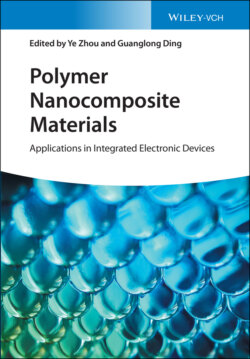Читать книгу Polymer Nanocomposite Materials - Группа авторов - Страница 30
2.1 Introduction
ОглавлениеCompared with traditional conductive materials like metals, conductive polymers (CPs) exhibit excellent flexibility, light weight, low cost, and easy processing characteristics. Therefore, CPs have become the research hotspot in recent decade and been widely used in many fields such as electromagnetic interference (EMI) shielding, sensors, and wearable electronics [1–3]. Generally, CPs can be divided into two categories: (i) structural (intrinsic) structural conductive polymers (SCPs) and (ii) conductive polymers composites (CPCs).
SCPs refer to a material possessing inherent conductivity provided by the structure carrier. The SCPs were firstly discovered in the 1970s, which aroused the attention of researchers on the chemical structure and the electrical properties of polymers [4, 5]. The common types of SCPs possessing conjugated bonds are polyacetylene, polypyrrole (PPy), polyaniline (PANI), polyphenylacetylene (PPA), and their derivatives. However, the value of electrical conductivity for the conjugated polymer materials is relatively small, usually ranging from 10−10 to 10−5 S cm−1. The electrical conductivity of polymer materials can be enhanced by 104 S cm−1 by doping various molecules like salt ions, hyaluronic acid, and peptides [6, 7]. The doped SCPs show both electrical conducting property from metallic material and many merits like flexibility, lightweight, etc., from polymer material. Therefore, The SCPs have demonstrated their potential applications in flexible electronics, sensors, and EMI shielding [8–10]. However, the SCPs have their inherent deficiencies including poor solubility, mechanical properties, and high cost. Usually, further modification or compounding with other polymers is needed to improve their overall performance [11].
CPCs refer to one kind of electrically conductive polymer composite materials fabricated by incorporating the conductive fillers [carbon black (CB), carbon nanotubes (CNTs), graphene, etc.] into insulating polymer matrix [12–14]. The electrical conductivity of CPCs is highly related with the percolated conductive network constructed by different conductive nanofillers. It is believed that most of the resistance comes from tunneling between adjacent conductive fillers dispersed in polymer matrix [15]. CPCs based on non-conductive polymer elastomers and conductive fillers have caused wide concern of both academic and industrial group and become a hot topic of polymer composites due to its easy preparation, controllable electrical property, excellent flexibility, and stretchability. In this chapter, we systematically introduce the development and prospect of CPCs through several parts including the fabrication method of CPCs, morphology, and microstructure of CPCs and their application as sensors.
